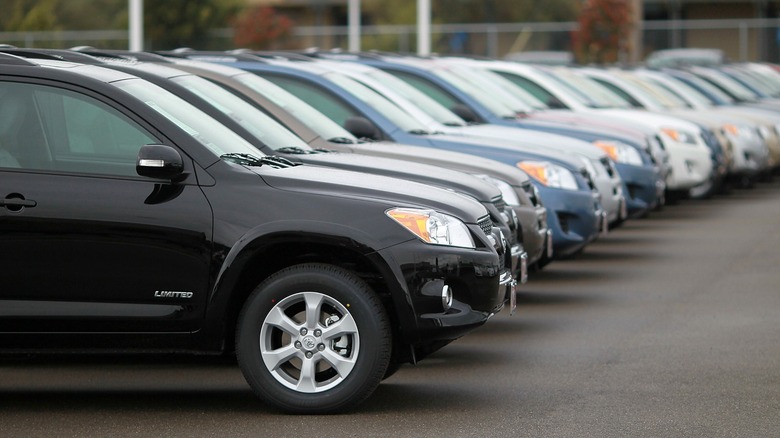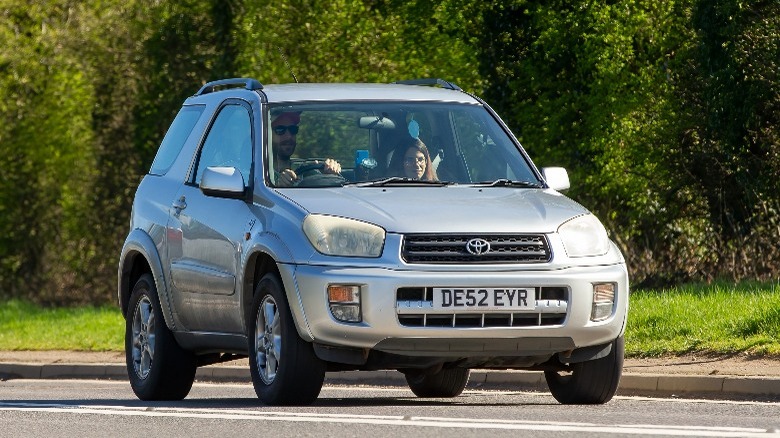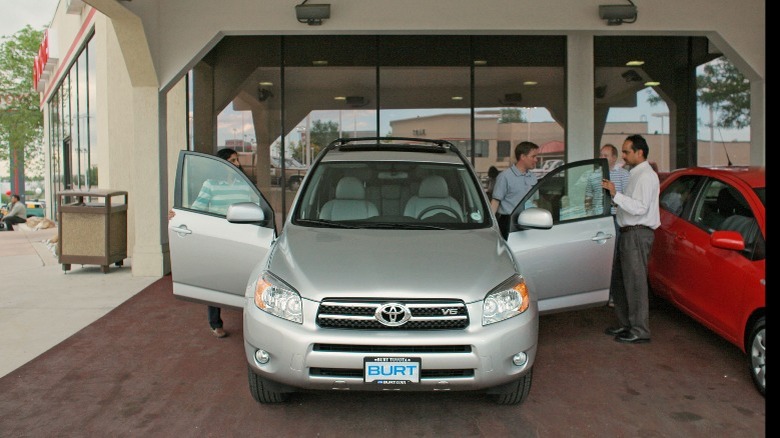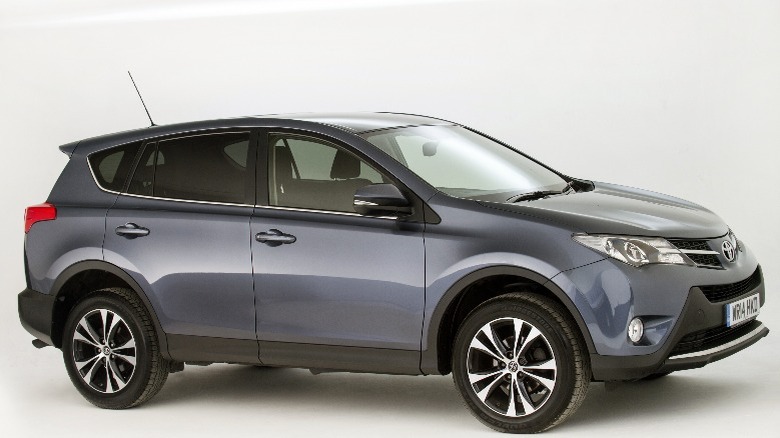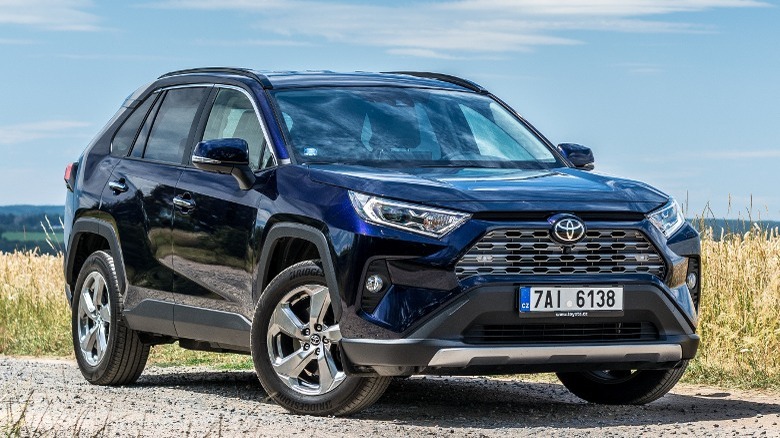Here Are Some Toyota RAV4 Years You Might Want To Avoid
The RAV4 is Toyota's best-selling SUV. You almost can't go wrong simply plucking one fresh off the lot. The RAV4 is versatile, reliable, and affordable. It's the kind of car you get when you need something practical and fuel-efficient that will last you a lifetime. It ranks highly on the list of the most reliable and cheap used Toyota models.
But, not all RAV4s will give you a smooth experience. There are some years you should avoid because they are more prone to trouble than others. It's worth noting that the RAV4 years we put on this list are by no means bad cars. Some of the problems here can be addressed with a little creative mechanical work, and others can even be managed with diligent car care and servicing. Even the worst RAV4s are more reliable than many car brands out there.
The RAV4 years we rank here should only be avoided because there are simply better RAV4 options out there. If you're going to spend money buying a used RAV4, you might as well squeeze every bit of value you can get out of it.
2001 to 2003
When Toyota released the second generation RAV4, it addressed concerns in the older model. It was bigger and came with a lot more punch than the pre-2000 RAV4, with a 148-horsepower VVT-i engine. However, around 2001, a new problem crept into the blossoming C-SUV: transmission failures.
The 2002 RAV4 is the RAV4 with the most complaints of all time on CarComplaints.com. Most of these problems come from the jerky, stiff transmission that jumps between gears. Also, the car is prone to engine control module (ECM) failure, and this untrustworthy ECM is the culprit behind the transmission problems.
Class action lawsuit threats and several complaints forced Toyota to extend the warranty on RAV4 models from 5 years and 60,000 miles to 10 years and 150,000 miles. Toyota also said they would reimburse customers who had already spent money fixing the issue as long as they could show reasonable proof.
Lastly, these cars are two decades old. They've seen tens to hundreds of thousands of miles, and while you could get one really cheap, the engines are more likely to fail before you get the chance to sell it. They are also missing a lot of new technology and power that now constitutes important parts of driving comfortably and safely. It's better to avoid these models entirely and pick something newer where you can.
2006 to 2008
The 2006, 2007, and 2008 RAV4s are another famously problematic trilogy. These cars came around the years Toyota built engines that were unfortunately oil-guzzling. In the case of these RAV4s, they were fitted with the 2AZ-FE engine, one of the least reliable engines Toyota has ever designed. It wasn't just the RAV4 that was affected, though; all the other cars with this engine were impacted, including the 2007 Camry.
What causes this excessive oil consumption is simply how the engine was designed. The piston rings don't scrape off enough oil from the combustion chamber, and the excess leftover oil gets burned up in combustion. This means it's not a problem you can easily fix; you can only manage it by replenishing the oil as often as possible. It's one of the common problems for the RAV4.
Toyota RAV4 models from around this year are also known to develop clunking sounds when you turn the steering wheel. Many owners say that a replacement steering shaft assembly fixed the issue. It's a repair that may cost you somewhere around $1,000. With most of these used RAV4s now having many miles on the odometer — some of those miles possibly on low engine oil, mind you — it's better to avoid them, or you might end up with a problematic SUV.
2014
The 2014 RAV4 would have been a good car if it hadn't been for the possibility of catching fire. In November 2023, the NHTSA issued a recall for Toyota RAV4s spanning from 2013 to 2018, affecting almost 2 million vehicles.
It's not like the car's engine would spontaneously combust or anything like that. Instead, this poorly designed 12-volt replacement battery has a smaller top than the original. So, when driving a little rough, it could free itself from the hold-down clamp and come in contact with it, causing a short circuit and eventual fire.
Of course, the battery fire isn't unique to the 2014 RAV4, but this, combined with some other problems it has, makes less desirable. The 2014 RAV4 is plagued with poor interior quality problems, like navigation screen glare, general infotainment system failure, and (while rarer) electric system failure. That's not all, though. RAV4s from this year with factory white paint could experience bubbling and peeling. Toyota started a customer support program to address 2008 to 2017 RAV4s, as they will likely have this problem.
We'd recommend you skip the 2014 model and either go back to a 2013 or forward to 2015; they're less likely to give you a headache.
2019
CarComplaints.com ranks the 2019 RAV4 as the worst RAV4 model. It's not because it has the most complaints, but because it has many considering its young age and the severity of these problems presenting at low mileage. Also, many of these repairs for this model are more expensive than older models.
The 2019 RAV4 has seen seven NHTSA recalls. The problems include fuel pump failure, loss of electric power steering, suspension problems, coolant leakage, and a few other minor issues. However, users also voice concerns about a jerky transmission that hesitates to shift gears. Although that problem could still be traced back to a faulty fuel pump.
Owners on Vehicle History have complained vehemently about several quality-of-life issues, and the car has earned a one-star rating for satisfaction. A popular problem among 2019 RAV4 drivers is that there are leaks coming through the roof rack seals. The water can seep into your vehicle and damage the pillars' airbags, posing safety risks.
Toyota has tried to address many of these problems through TSBs and recalls, and you could actually get a decent 2019 RAV4 now. But since you're looking for years to avoid, 2019 is one of those you best ignore if you don't want problems.
